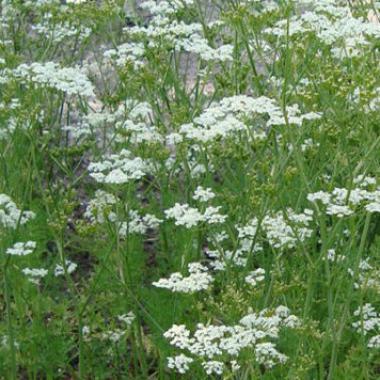


Caraway (Meridian fennel, Persian cumin)
Carum carvi

Caraway plants are rarely seen in herb gardens, which is a pity as all plants of the herb are edible.
They look lovely in both herb garden or border, and can be grown alongside our cornflowers (Centaurea cyanus) to give a lovely flowering effect.
In the first year caraway does not flower but produces a fountain of feathery foliage 20 cm high,
rather like a carrot, and a long tap root.
In autumn the foliage dies back completely and re-grows in the spring of the following year, sending
up multiple flowering stems in May topped with masses of white flowers rather like a small and
elegant cow parsley. These flowers are very attractive to all manner of beneficial insects.
The flowers as they die develop into the well known caraway seeds which ripen to become hard and
brown — ready to harvest. It is good to plant a second crop a year after the first so that you have a continuous supply.
All parts of the plants are edible.
The young leaves can be harvested to add to salads, soft cheese and herb butters, and also used as a
herby garnish to soups and stews.
The roots look like a white carrot. You can thin out your caraway at the end of the first year and
use the tap root as you would use a parsnip — steamed or added chopped up to casseroles.
Or use the roots after harvesting the seeds in the second year, these maybe a little tougher than the first year roots.
The seeds are the part of the plant which most of us will recognise. These are ready for harvest
when they are dark brown. Dry the umbels in open paper bags for a week or so before stripping from
the stems and storing in jars.
The seeds, either whole or ground, can be used in an endless variety of dishes.
Most well-known is the use of the seeds in rye bread, pickles and with brassicas like cabbage and
cauliflower. They are versatile and recipes use caraway seeds in all sorts of baking, soups, stews
and sauces, also with eggs and cheese and to enhance fruit dishes like apple.